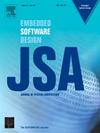Back to fundamentals: Low-level visual features guided progressive token pruning
IF 4.1
2区 计算机科学
Q1 COMPUTER SCIENCE, HARDWARE & ARCHITECTURE
引用次数: 0
Abstract
Vision Transformers (ViTs) excel in semantic segmentation but demand significant computation, posing challenges for deployment on resource-constrained devices. Existing token pruning methods often overlook fundamental visual data characteristics. This study introduces ‘LVTP’, a progressive token pruning framework guided by multi-scale Tsallis entropy and low-level visual features with twice clustering. It integrates high-level semantics and basic visual attributes for precise segmentation. A novel dynamic scoring mechanism using multi-scale Tsallis entropy weighting overcomes limitations of traditional single-parameter entropy. The framework also incorporates low-level feature analysis to preserve critical edge information while optimizing computational cost. As a plug-and-play module, it requires no architectural changes or additional training. Evaluations across multiple datasets show 20%–45% computational reductions with negligible performance loss, outperforming existing methods in balancing cost and accuracy, especially in complex edge regions.
回到基本原理:低级的视觉特征引导逐步的标记修剪
视觉转换器(Vision transformer, ViTs)在语义分割方面表现优异,但计算量大,这给在资源受限设备上的部署带来了挑战。现有的标记修剪方法往往忽略了基本的视觉数据特征。本研究引入了一种基于多尺度Tsallis熵和二次聚类的低层次视觉特征的渐进式标记修剪框架“LVTP”。它集成了高级语义和基本视觉属性,用于精确分割。一种基于多尺度Tsallis熵加权的动态评分机制克服了传统单参数熵的局限性。该框架还结合了低级特征分析,以在优化计算成本的同时保留关键边缘信息。作为即插即用模块,它不需要架构更改或额外培训。跨多个数据集的评估显示,计算量减少了20%-45%,性能损失可以忽略不计,在平衡成本和准确性方面优于现有方法,特别是在复杂的边缘区域。
本文章由计算机程序翻译,如有差异,请以英文原文为准。
求助全文
约1分钟内获得全文
求助全文
来源期刊

Journal of Systems Architecture
工程技术-计算机:硬件
CiteScore
8.70
自引率
15.60%
发文量
226
审稿时长
46 days
期刊介绍:
The Journal of Systems Architecture: Embedded Software Design (JSA) is a journal covering all design and architectural aspects related to embedded systems and software. It ranges from the microarchitecture level via the system software level up to the application-specific architecture level. Aspects such as real-time systems, operating systems, FPGA programming, programming languages, communications (limited to analysis and the software stack), mobile systems, parallel and distributed architectures as well as additional subjects in the computer and system architecture area will fall within the scope of this journal. Technology will not be a main focus, but its use and relevance to particular designs will be. Case studies are welcome but must contribute more than just a design for a particular piece of software.
Design automation of such systems including methodologies, techniques and tools for their design as well as novel designs of software components fall within the scope of this journal. Novel applications that use embedded systems are also central in this journal. While hardware is not a part of this journal hardware/software co-design methods that consider interplay between software and hardware components with and emphasis on software are also relevant here.
 求助内容:
求助内容: 应助结果提醒方式:
应助结果提醒方式:


